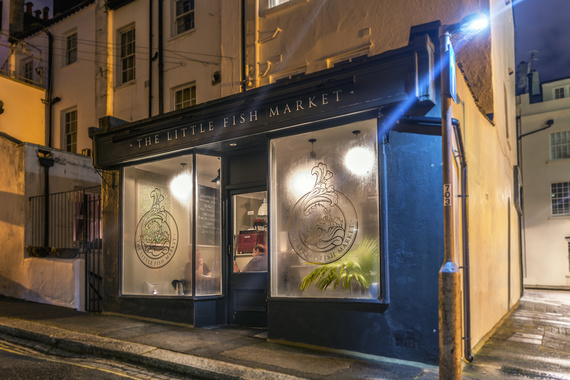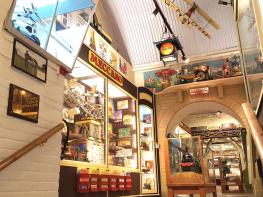Located in the grounds of Newtimber Place, a beautiful 17th-century moated house within the…
Grand views from Devil's Dyke

A fine walk with glimpses over the most famous of all the dry chalk valleys.
2.75 miles (4.4kms)
About the walk
Sussex is rich in legend and folklore, and the Devil and his fiendish works crop up all over the county. The local landmark of Devil’s Dyke is a prime example, perfectly blending the natural beauty of the South Downs with the mystery and originality of ancient mythology. Few other fables in this part of the country seem to have caught the public imagination in quite the same way.
Devil’s Dyke is a geological quirk, a spectacular, steep-sided downland combe or cleft 300ft (91m) deep and half a mile (800m) long. According to legend, it was dug by the Devil as part of a trench extending to the sea. The idea was to try to flood the area with sea water and, in so doing, destroy the churches of the Weald. However, it seems that the Devil might have been disturbed by a woman carrying a candle. Mistaking this for the dawn, he quickly disappeared, leaving his work unfinished. It’s a charming tale, but the reality of how Devil’s Dyke came to be is probably a good deal less interesting. No one knows for sure how it originated, but it is most likely to have been cut by glacial meltwaters when the ground was permanently frozen in the Ice Age.
Rising to over 600ft (180m), this most famous of beauty spots is also a magnificent viewpoint where the views stretch for miles in all directions. The Clayton Windmills are visible on a clear day, as are Chanctonbury Ring, Haywards Heath and parts of Ashdown Forest. The artist Constable described this view as the grandest in the world.
Devil’s Dyke has long been a tourist hotspot. During the Victorian era and in the early part of the 20th century, the place was akin to a bustling theme park with a cable car crossing the valley and a steam railway coming up from Brighton. On Whit Monday 1893 a staggering 30,000 people visited Devil’s Dyke. In 1928 HRH the Duke of York dedicated the Dyke Estate for the use of the public forever, and in fine weather it can seem just as crowded as it was in Queen Victoria’s day. With the car park full and the surrounding downland slopes busy with people simply taking a relaxing stroll in the sunshine, Devil’s Dyke assumes the feel of a seaside resort at the height of the season. Hang-gliders swoop silently over the grassy downland like pterodactyls and kite flyers spill from their cars in search of fun and excitement. But don’t let the crowds put you off. The views more than make up for the invasion of visitors, and away from the chalk slopes and the car park the walk soon heads for more peaceful surroundings. Beginning on Summer Down, on the route of the South Downs Way, you drop down gradually to the village of Poynings, where there may be time for a welcome pint at the Royal Oak. Rest and relax for as long as you can here because it’s a long, steep climb to the Devil’s Dyke pub. The last leg of the walk is gentle and relaxing by comparison.
Walk directions
With the road behind you, take the kissing gate on the right side of the car park, go down across the grass for a few paces, then turn right on a path which you follow, soon passing a railing round a covered grass-topped reservoir. Soon the path curves left and drops down to the South Downs Way, which leads to a road. Part company with the South Downs Way at this point, as it crosses over to join the private road to Saddlescombe Farm, and follow the verge for about 75yds (68m). Bear left at the footpath sign and drop down the bank to a stile.
Follow the line of the tarmac lane as it curves right to reach a waymark. Leave the lane and walk ahead alongside power lines, keeping the line of trees and bushes on your right. Eventually veer right into the vegetation and cross a stile. Drop down into the woods and turn right at a junction with a bridleway. Past a pond, reach a path junction at the edge of the wood and fork left between fields and a wooded dell; go around a lake to a signposted stile. Turn right towards Poynings.
Head for a gate and footpath sign and cross the road, turning left along the parallel path along to the Royal Oak and then in to Dyke Lane on the left. There is a memorial stone here, dedicated to the memory of George Stephen Cave Cuttress, a resident of the parish for over 50 years, and erected by his widow. Follow the tarmac bridleway, and soon it narrows to a path. On reaching the fork, by a National Trust sign for Devil’s Dyke, veer right and then fork left to begin climbing the steps.
Follow the steps up to a kissing gate and continue up the stairs. From the higher ground there are breathtaking views to the north and west. Fork right to a guidepost bearing purple and orange arrows, ignoring a left turn that rises steeply to a stile. Carry on to a kissing gate and head up the slope towards the Devil’s Dyke pub, keeping it to your left. Take the road round to the left past the pub car park, walking along the footway beside the left side of the road past a bridleway sign, and look to the left for a definitive view of Devil’s Dyke.
At a National Trust sign for Summer Down turn left on the South Downs Way. Follow the trail, keeping Devil’s Dyke down to your left, and eventually reach Summer Down car park.
Additional information
Field and woodland paths, several stiles
Chalk grassland, steep escarpment and woodland
Mostly off lead. On lead on approach to Poynings
OS Explorer OL11 Brighton & Hove
Devil's Dyke Summer Down free car park
By Devil's Dyke pub
WALKING IN SAFETY
Read our tips to look after yourself and the environment when following this walk.
Find out more
Also in the area
About the area
Discover West Sussex
Divided from East Sussex back in 1888, West Sussex is so typically English that to walk through its landscape will feel like a walk through the whole country. Within its boundaries lies a wide variety of landscape and coastal scenery, but it is the spacious and open South Downs with which the county is most closely associated.
In terms of walking, you’ll be spoilt for choice. Studying the map reveals a multitude of routes – many of them to be found within the boundaries of the South Downs National Park – and an assortment of scenic long-distance trails leading towards distant horizons; all of them offer a perfect way to get to the heart of ‘Sussex by the sea,’ as it has long been known. If you enjoy cycling with the salty tang of the sea for company, try the ride between Chichester and West Wittering. You can vary the return journey by taking the Itchenor ferry to Bosham.
West Sussex is renowned for its many pretty towns, of course. Notably, there is Arundel, littered with period buildings and dominated by the castle, the family home of the Duke of Norfolk, that dates back nearly 1,000 years.
Nearby stays
Restaurants and Pubs
Nearby experiences
Recommended things to do
Why choose Rated Trips?
Your trusted guide to rated places across the UK
The best coverage
Discover more than 15,000 professionally rated places to stay, eat and visit from across the UK and Ireland.
Quality assured
Choose a place to stay safe in the knowledge that it has been expertly assessed by trained assessors.
Plan your next trip
Search by location or the type of place you're visiting to find your next ideal holiday experience.
Travel inspiration
Read our articles, city guides and recommended things to do for inspiration. We're here to help you explore the UK.
















